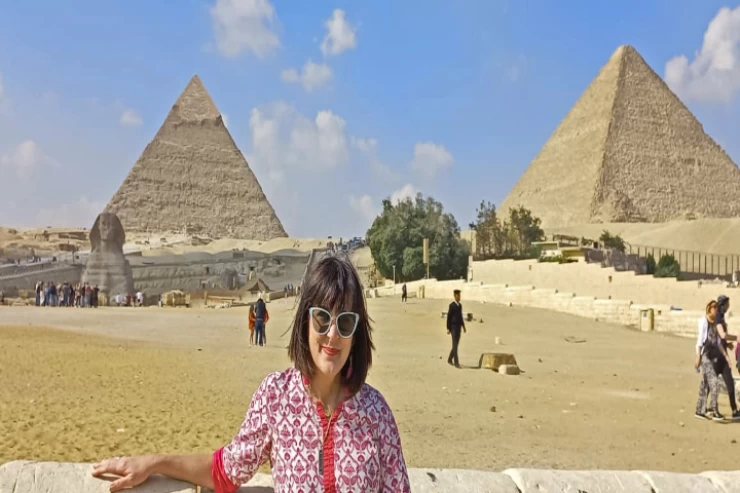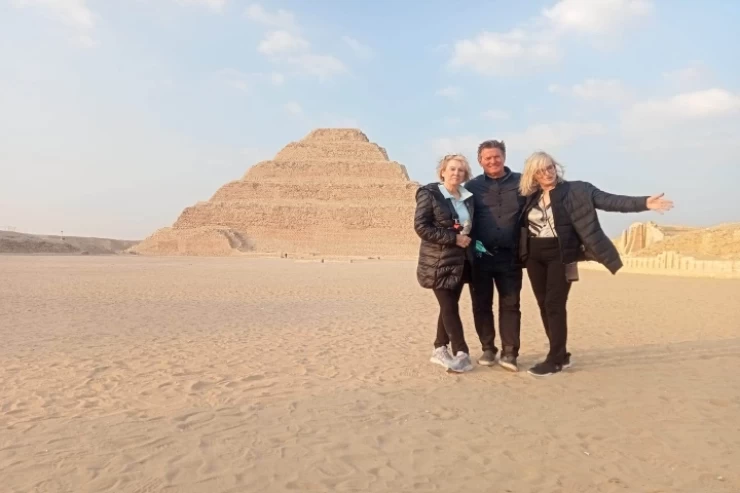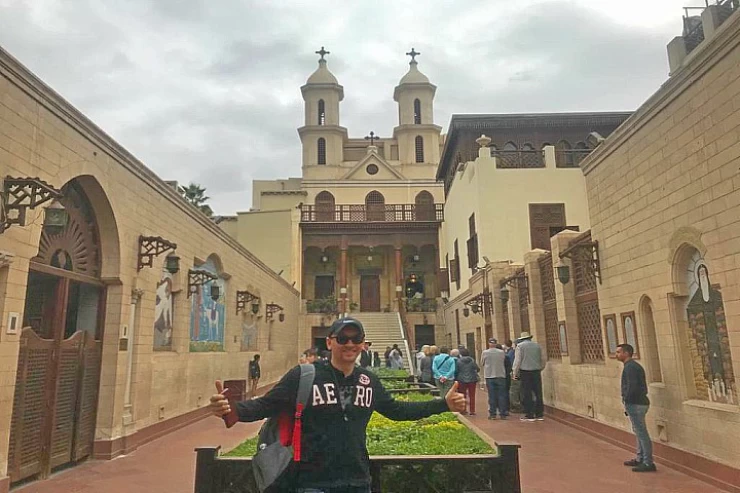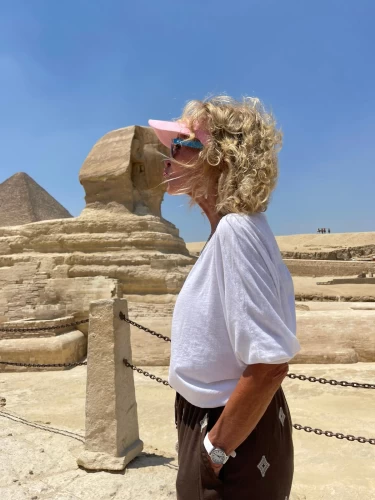
La Religión en Egipto
La religión en Egipto controla muchos aspectos de la vida social y está respaldada por la ley. La religión estatal de Egipto es el Islam. Aunque las estimaciones varían mucho en ausencia de estadísticas oficiales. Desde el censo de 2006, la religión ha sido excluida y, por lo tanto, las estadísticas disponibles son estimaciones realizadas por organismos religiosos y no gubernamentales. El país es mayormente musulmán suní (con estimaciones que oscilan entre alrededor del 80% y el 94%), y el siguiente grupo religioso más grande es el de cristianos coptos (con estimaciones que van del 6% al 20%). Los números exactos están sujetos a controversia, y los cristianos alegan que han sido sistemáticamente subestimados en los censos existentes.
Egipto alberga dos importantes instituciones religiosas. La mezquita Al-Azhar, fundada en 970 dC por los fatimíes como la primera universidad islámica en Egipto y la Iglesia ortodoxa copta de Alejandría, establecida a mediados del siglo I por San Marcos.
En Egipto, musulmanes y cristianos comparten una historia común, identidad nacional, etnicidad, raza, cultura e idioma.
Una escena religiosa común en Egipto: una mezquita junto a una iglesia.
En 2002, bajo el gobierno de Mubarak, la Navidad copta (7 de enero) fue reconocida como un día festivo oficial, aunque los cristianos se quejan de estar mínimamente representados en la aplicación de la ley, la seguridad del estado y la oficina pública, y de ser discriminados en la fuerza laboral por motivos de su religión.
Relaciones con la minoría copta.
Los cristianos coptos, que son la minoría etnorreligiosa más grande de Egipto, son los más afectados por la legislación posiblemente discriminatoria. Los coptos en Egipto han enfrentado una creciente marginación después del golpe de Estado de 1952 dirigido por Gamal Abdel Nasser. Hasta hace poco, se requería que los cristianos obtuvieran la aprobación de la Presidencia incluso para reparaciones menores en iglesias. Aunque la ley se suavizó en 2005 al entregar la autoridad de aprobación a los gobernadores, los coptos continúan enfrentando muchos obstáculos en la construcción de nuevas iglesias. Estos obstáculos no son tanto en la construcción de mezquitas.
Religión egipcia antigua
La antigua religión egipcia era un complejo sistema de creencias y rituales politeístas que formaban parte integrante de la antigua sociedad egipcia. Se centró en la interacción de los egipcios con muchas deidades que se cree que están presentes en el mundo y que lo controlan. Rituales como la oración y las ofrendas fueron proporcionados a los dioses para ganar su favor. La práctica religiosa formal centrada en los faraones, los gobernantes de Egipto, creían poseer un poder divino en virtud de su posición. Actuaron como intermediarios entre su gente y los dioses, y se vieron obligados a sostener a los dioses a través de rituales y ofrendas para que pudieran mantener a Ma'at, el orden del cosmos. El estado dedicó enormes recursos a los rituales religiosos ya la construcción de templos.
Las personas pueden interactuar con los dioses para sus propios fines, pidiendo ayuda a través de la oración o obligando a los dioses a actuar a través de la magia. Estas prácticas eran distintas, pero estaban estrechamente relacionadas con los rituales e instituciones formales. La tradición religiosa popular se hizo más prominente en el curso de la historia egipcia a medida que el estado del faraón declinó. La creencia egipcia en la vida después de la muerte y la importancia de las prácticas funerarias es evidente en los grandes esfuerzos realizados para asegurar la supervivencia de sus almas después de la muerte, a través de la provisión de tumbas, bienes graves y ofrendas para preservar los cuerpos y espíritus de los difuntos.
La religión tenía sus raíces en la prehistoria de Egipto y duró más de 3.000 años. Los detalles de la creencia religiosa cambiaron con el tiempo a medida que la importancia de los dioses en particular aumentaba y disminuía, y sus relaciones intrincadas cambiaban. En varios momentos, ciertos dioses se volvieron preeminentes sobre los demás, incluido el dios sol Ra, el dios creador Amun y la diosa madre Isis. Durante un breve período, en la teología promulgada por el faraón Akhenaton, un solo dios, el Aten, reemplazó al panteón tradicional. La antigua religión y la mitología egipcia dejaron atrás muchos escritos y monumentos, junto con influencias significativas en las culturas antiguas y modernas.
Las creencias y rituales que ahora se denominan "religión del antiguo Egipto" eran parte integral de todos los aspectos de la cultura egipcia. La lengua egipcia no poseía un solo término que correspondiera al concepto moderno de religión europea. La antigua religión egipcia consistía en un vasto y variado conjunto de creencias y prácticas, unidas por su enfoque común en la interacción entre el mundo de los humanos y el mundo de lo divino. Las características de los dioses que poblaron el reino divino estaban indisolublemente vinculadas a la comprensión de los egipcios de las propiedades del mundo en que vivían.
Los egipcios creían que los fenómenos de la naturaleza eran fuerzas divinas en sí mismas. Estas fuerzas deificadas incluían los elementos, características animales o fuerzas abstractas. Los egipcios creían en un panteón de dioses, que estaban involucrados en todos los aspectos de la naturaleza y la sociedad humana. Sus prácticas religiosas fueron esfuerzos para sostener y aplacar estos fenómenos y convertirlos en una ventaja humana. Este sistema politeísta era muy complejo, ya que se creía que algunas deidades existían en muchas manifestaciones diferentes, y algunas tenían múltiples roles mitológicos. Por el contrario, muchas fuerzas naturales, como el sol, se asociaron con múltiples deidades. Los diversos panteones iban desde dioses con roles vitales en el universo hasta deidades menores o "demonios" con funciones muy limitadas o localizadas. Podría incluir a los dioses adoptados de culturas extranjeras y, en ocasiones, de seres humanos: se creía que los faraones fallecidos eran divinos y, en ocasiones, comuneros distinguidos, como Imhotep, también se deificaban.
Los egiptólogos han debatido durante mucho tiempo el grado en que el faraón era considerado un dios. Parece muy probable que los egipcios vieran a la autoridad real como una fuerza divina. Por lo tanto, aunque los egipcios reconocieron que el faraón era humano y estaba sujeto a la debilidad humana, al mismo tiempo lo veían como un dios, porque el poder divino de la realeza se encarnaba en él. Por lo tanto, actuó como intermediario entre el pueblo de Egipto y los dioses. Fue clave para defender a Maat, tanto al mantener la justicia y la armonía en la sociedad humana como al sostener a los dioses con templos y ofrendas. Por estas razones, supervisó toda la actividad religiosa del estado. Sin embargo, la influencia y el prestigio de la vida real del faraón podrían diferir de su representación en escritos y representaciones oficiales, y desde el último Reino Nuevo, su importancia religiosa declinó drásticamente.
Los egipcios tenían creencias elaboradas sobre la muerte y la vida futura. Creían que los humanos poseían un ka, o fuerza vital, que dejaba el cuerpo en el punto de la muerte. En la vida, el ka recibió su sustento de la comida y la bebida, por lo que se creía que, para resistir después de la muerte, el ka debía continuar recibiendo ofrendas de alimentos, cuya esencia espiritual aún podía consumir. Cada persona también tenía un ba, el conjunto de características espirituales únicas de cada individuo. A diferencia del ka, el ba permaneció unido al cuerpo después de la muerte. Los rituales funerarios egipcios tenían la intención de liberar el ba del cuerpo para que pudiera moverse libremente, y volver a unirlo con el ka para poder seguir viviendo como un akh. Sin embargo, también era importante que el cuerpo del difunto se conservara, ya que los egipcios creían que el ba regresaba a su cuerpo cada noche para recibir una nueva vida, antes de emerger en la mañana como un akh.
En los primeros tiempos se creía que el faraón fallecido ascendía al cielo y moraba entre las estrellas. En el transcurso del Reino Antiguo (c. 2686-2181 aC), sin embargo, llegó a estar más estrechamente asociado con el renacimiento diario del dios sol Ra y con el gobernante del inframundo Osiris, ya que esas deidades se hicieron más importantes.
En las completamente desarrolladas creencias sobre la vida futura del Nuevo Reino, el alma tuvo que evitar una variedad de peligros sobrenaturales en el Duat, antes de pasar por un juicio final, conocido como el "Pesaje del Corazón", realizado por Osiris y por los Evaluadores de Maat En este juicio, los dioses compararon las acciones de los fallecidos en vida (simbolizados por el corazón) con Maat, para determinar si él o ella se habían comportado de acuerdo con Maat. Si el fallecido fue juzgado como digno, su ka y ba se unieron en un akh. Varias creencias coexistieron sobre el destino del akh. A menudo se decía que los muertos moraban en el reino de Osiris, una tierra exuberante y agradable en el inframundo. La visión solar de la vida después de la muerte, en la que el alma fallecida viajaba con Ra en su viaje diario, todavía estaba asociada principalmente con la realeza, pero también podía extenderse a otras personas. En el transcurso de los Reinos Medio y Nuevo, la idea de que el akh también podría viajar en el mundo de los vivos, y hasta cierto punto, afectar mágicamente los eventos allí, se hizo cada vez más frecuente.
Tenemos las mejores ofertas y ofertas para que disfrute de una variedad de viajes y vacaciones en Egipto clásicos a medida, viajes privados de presupuesto a Egipto y paquetes de viajes a Egipto para satisfacer todos sus sueños sobre el antiguo Egipto, la cuna de las civilizaciones, lo ayudaremos a planificar sus paquetes clásicos a Egipto y que cubren la mayor parte de la tierra de los faraones, entonces le permitiremos probar la mejor calidad de servicio de viaje ofrecido por las guías de Cairo Top Tours. Reserve ahora para disfrutar de los paquetes de vacaciones en Egipto y paquetes turísticos en Egipto para visitar el increíble Giza. las pirámides de Giza y la Esfinge, el museo egipcio, el Valle de los Reyes, el Cairo copto e islámico, el Templo de Abu Simbel y todas las maravillas del antiguo Egipto.
If Egypt has often been referenced by historians as ‘the Cradle of Civilization’, it has probably one of the most complicated religious aspects in entire human history. The fertile banks of the Nile did host agriculture, but they also produced a vast culture, where religion permeated every single aspect of everyday life, politics, and social order. From the earliest days of ancient Egyptian civilization up to this day, despite being primarily a desert dry land, Egypt has been a melting pot of different religions, starting from polygamy to finally embracing monotheism.
In this piece, Section II, How We Were: Reflections on Egyptian History, From Ancient Polytheism to Christianity & Islam, will be reviewed and analyzed, as well as the role of religion in the lives of the Egyptian population.
As a society, it can be said that religion was the foundation of ancient Egypt. The ancient Egyptians worshiped as they knew that everything from the annual flooding of the Nile to the cycle of life and death was not only natural but controlled by some divine power. This was a belief characterized by a multiplicity of deities, all of whom were in charge of a specific facet of existence and/or nature.
The Major Gods and Goddesses
Ra (or Re): Revered as the God of the Sun, Ra has been depicted as the most potent deity in ancient Egyptian religion. It was believed that Ra inhabited the sky during the day, providing light to the earth, and resided in the underworld at night. He would oftentimes be portrayed with a falcon’s head and wear a sun disk on top of his head.
Osiris: Osiris was an Egyptian death and resurrection god and held a significant place in Egyptian mythology in representing the concept of life as a cycle of birth, death, and resurrection. The Osiris myth and his resurrection, in the capable hands of Isis, his wife, became the pillars of the Egyptian afterlife experience.
The goddess was immensely popular and powerful. She was a protector of motherhood, magic, and fertility. Her protective aspect and the ability to bring Osiris back to life made her worshiped.
Horus, the god of the sky and of the king, is often shown as a hawk. He was also known because of his rivalry with the chaos god Set for dominion over the land of Egypt, which represents the struggle of order and chaos.
Anubis is the Egyptian god associated with funerary rites and the protection of the dead. He had the important task of supervising the ceremony of the heart's weighing, which assessed a person’s spirit in the next world.
The gods were not distant or abstract figures; they were present in every facet of life. Egyptians built temples across the country, conducted elaborate rituals, and offered daily prayers and sacrifices to ensure the favor of the gods and maintain ma’at—harmony and order.
Worship wasn’t the only reason for building temples; these structures were believed to be the earthly homes of the gods. The pharaohs had enormous temples like Karnak and Luxor built to worship and carry out rituals for the gods as well as to showcase the power of their rule over the land. No one was permitted to enter the temple’s most sacred, innermost areas except for the priests, who were thought to be the only ones capable of interacting with the gods.
Priests offered meals, incense, and prayers to the gods on a daily basis, performing their duties towards ensuring the gods’ continuous provision of security over the land of Egypt. These clergymen were very powerful and at times even had political authority as they helped the pharaohs in religious affairs.
For the Ancients, death was not a permanent end; there would be life after death. This notion fueled the people’s efforts to focus on death and think about how they would prepare in the appropriate way for their journey to the underworld, which in their minds was not an easy place to reach but one that guaranteed everlasting bliss as long as the challenges were overcome.
Mummification and the Preservation of the Body
Mummification was pivotal in shaping the Egyptian view of what happens when one dies. The body was to be maintained so that the ‘ka’ (or soul) would remember and go back to its residence after death. Mummification came to be practiced with a set of procedures that included arts of organ procurement, chemical treatment, and linen envelopment of the entire body.
A process of putting up preparatory arrangements for one’s afterlife would also include making tombs, which would have items that the dead person would require, such as food, clothes, and upright ‘ushabti’ figures meant to depict servants. The magnificence that royal burial places such as the Giza pyramids and those in the Valley of the Kings display indicates the extreme measures taken to ensure adequate rest and healthcare for the leaders when they die.
The mummification custom was bound to the Egyptian people's love of the afterlife. Bodies had to be maintained in a way that allowed the spirit, or 'ka', to identify it and be able to go back in after death. Mummification came to be seen with specific practices, which included the arts of organ downsizing, substance drying, and body plastering with bandages.
Another aspect of preparing for eternity was that of constructing tombs containing the essentials for the deceased, such as an abundance of food and clothes and miniature statues of servants known as ushabtis. Such an adulation can be seen from the wonderful construction of royal burial sites such as those surrounding the Great Pyramids of Giza and along the Valley of the Kings, where endless hope lies for the reasonable resting of the leaders within the period of their deaths.
The “weighing of the heart” ritual is one of the key convictions regarding the hereafter. In Egyptian cosmology, when a deceased individual was brought to the land of the dead, the god Anubis was tasked with weighing the heart against the feather of Ma’at, the deity representing truth and justice. Where the scales tipped in favor of the feather, the individual was considered fit to take his place among the dead in the other world. If the heart tipped the scale against the feather, then due to some impertinent act or lie, that heart would be consumed by the ferocious goddess Amit and the essence would no longer exist.
3. The Introduction of Monotheism: The Amarna Period
Throughout the reign of Pharaoh Akhenaten, also known as Amenhotep IV, which was between the years 1353 and 1336 BCE, many changes were witnessed, especially in Egyptian religious practices. Akhenaten believed there was only one God to worship, and that was Aten, the sun disk, and he promoted the worship of Aten only. He constructed a new city called Akhetaten (Amarna, modern) and concentrated on the worship of this one god, excluding completely the rest of the traditional deities in the Egyptian pantheon.
The extent of how long this extreme change in religious practices lasted is very minimal. After the death of Akhenaten, the former worship of many gods was reinstated by the administrations that followed him, particularly through King Tutankhamun, and the cult of Aten was, for the most part, expunged from history. Still, the issue of Akhenaten's obsessive tendencies concerning religion remains a curious page in the story of religions in ancient Egypt. It demonstrates how potential changes in religion can be such a threat even when a rigid system is in place.


















